#fiber content
Explore tagged Tumblr posts
Text
The Why of Sewing 3: Fabric Anatomy (Fiber Content)
This post is in a series I am starting that is going to talk about concepts in sewing and fiber arts and try and explain some of the whys behind the hows.
The beginner sewist is often (correctly) advised at the beginning of their journey to start with cotton fabric, sometimes specifically woven cotton, but not always. Nevermind that cotton fabric can vary from a tshirt to denim and canvas.
We have learned the difference between a knit and a woven fabric in my previous posts (check the tag #the why of sewing which should bring up the whole series). Let's talk fiber content.
Like fabric structure I basically break fiber down into two groups: natural fibers and synthetic fibers. Below I am going to talk about the fibers you are most likely to encounter as you shop as a home sewist. It is NOT a complete list of fibers, nor could I list the entirety of fabric types made with each fiber.
Natural fibers: these are fibers that come from plants and animals and require minimal processing to be made into fabric.
Wool: This comes from sheep, which are sheared 1-2 times a year. The animal is not hurt in the process and even sheep not raised for fiber production must be sheared for their health. Wool is warm, but breathable. It can be easy to work with in some ways, but it does shrink when washed and so many modern sewists avoid wool. Some folks have sensitivities to wool as well. Wool is most commonly used in suitings and knits.

Image: Shorn sheep in a verdant field (Source: By Roger Kidd, CC BY-SA 2.0, https://commons.wikimedia.org/w/index.php?curid=13035358)
Silk: Silk is made from the cocoons of silkworms, and generally harvested prior to the hatching of silkworm larvae. Silk is expensive to produce and considered a luxury good. Silk is shiny and lightweight, it can be surprisingly warm. Silk can loose its sheen in the wash and because the fiber is so delicate it can be difficult to sew. There is a lot of misinformation on the production of both silk and wool online. Worm Spit has been educating fiber artists about the process of making silk since 2002.

Image: a vintage style poster showing various stages of the silkworm moth (By Bibliographisches Institut, in Leipzig - Meyers Konversations-Lexikon, 4th Auflage, Band 14, Seite 826a (4th ed., Vol. 14, p.826a), Public Domain, https://commons.wikimedia.org/w/index.php?curid=2317808)
Cotton: Cotton comes from the cotton plant, there are several varieties commonly grown and it is the most common natural fiber used in textile production. The cotton fiber comes from the seed head of the plant. Cotton can be made into light breathable fabrics and warm cosy fabrics. The list of fabrics made from cotton might actually be endless but here are a few you might encounter: jersey knits, denim, quilting cotton, gauze, lawn, voile, sweatshirting, twills, poplin, oxford cloth, canvas...

Image: the cotton boll, or seed pod (source: Public Domain, https://commons.wikimedia.org/w/index.php?curid=689304)
Linen: Linen comes from the flax plant. The fiber comes from the long stem of the flax plant and can be difficult to break down into a usable state. It is also difficult for modern spinning equipment to make into threads, which is why linen tends to be quite expensive in comparison to cotton. Linen is cool to the touch and very strong. It also wrinkles very easily. Coarsely woven linen can be uncomfortable for some to wear. Linen tends to be made into simple plain woven fabric, occasionally knit fabrics, and can vary in weight from handkerchief linen (very fine, almost transparent) to canvas. I recently reblogged THIS POST which had some incredible links regarding linen production.
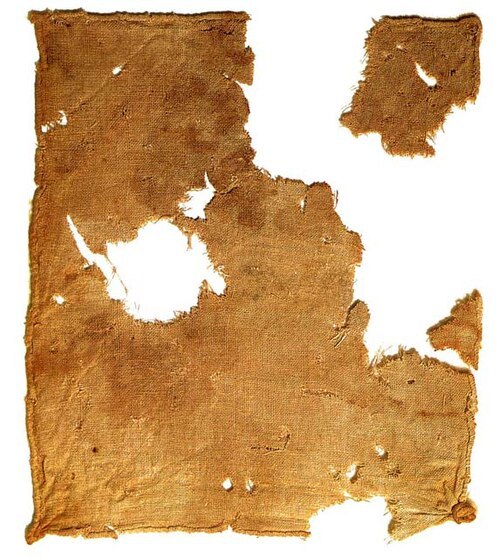
Image: linen cloth recovered from Qumran Cave 1 near the Dead Sea (Public Domain, https://commons.wikimedia.org/w/index.php?curid=248420)
Synthetic fabrics: these are fibers that have been manufactured through industrial processes.
Polyester/Acrylic/Nylon: These fabrics are plastic. They are made from different types of plastic, but ultimately a liquid petrolum product is extruded into a long filiment and made into cloth. They can be made into woven or knit fabric. The way they are made can have many different properties. Generally polyester is what you find in the home sewing world. Polyester is not breathable and because it is oil based it tends to hold on to smells. It melts when it is too hot and therefore can only be ironed carefully. Polyester also tends to be very strong and can help make very sturdy fabrics. Because polyester is very inexpensive to produce it is frequently combined with other fibers to reduce production cost.
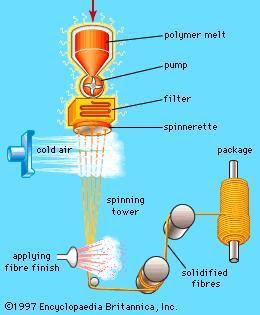
A diagram of "dry spinning" polyester fibers (source: https://encyclopedia.che.engin.umich.edu/fiber-spinning/)
Spandex/Lycra/Elastine: this is the stretchy stuff! Generally found in combination with other materials this is what makes fabric go beyond the mechanical stretch that is produced by the fabric structure. In small amounts mixed with cotton it makes a fantastic tshirt jersey, 100% spandex is great for swim and dancewear. As we discussed in the knit article I posted previously adding stretch to sewing does make it more complicated to work with, but used wisely spandex is your friend. Best not pressed excessively as the fiber has a protein structure that breaks down when it is hot. Also if you have a garment or fabric with a lot of spandex content you might want to consider avoiding the dryer.
Rayon/Viscose/Bamboo/Lyocell/Cupro/Tencel: There are SO MANY names for cellulose fabrics. These are sometimes categorized as semi-synthetic fibers, or even put in with natural fibers. They are all the same thing deep down. Cellulose (generally sourced from trees and plants) is chemically broken down into its most essential parts and then extruded into a filiment. These fibers were originally developed as a silk substitute. Rayons are fine, breathable, and have a drape that clings to the body. They shrink in the wash and can continue to shrink through several washes. They also can be fragile when wet. Rayons are made into both woven fabrics and knits and they tend to be thin and fine fabrics. Rayon fabrics, especially those labeled as bamboo are frequently greenwashed as environmentally friendly, because they are sourced from a renewable resource, but the process of producing cellulose fibers is highly polluting and uses significant amounts of water.
While there are outliers, most textiles you will encounter while shopping for fabric will be made of the above fibers. A deeper dive into these would be fun, but I find at least 3 potential rabbit holes I could go down every single post I make here.
#quilting#sewing#sewing tutorial#fabric#textile art#sewing tips#sewing techniques#the why of sewing#fabric content#fiber#fiber content#cotton#wool#linen#silk#rayon
106 notes
·
View notes
Text
106 notes
·
View notes
Text
yep, my favorite fabric thrift store does this, and periodically teaches classes too.
Get yourself a fabric store that will light your fabric on fire for you
No but legit I asked what the fiber content of something was and the guy didn’t know so he cut a chunk off and lit it on fire and felt the ashes and was like. Yeah this is mostly cotton with a lil bit of silk. And that was the moment I knew. This is it. This is the fabric store for me. Also that guy is marriage material. Not for me but damn some person is gonna be so happy with him.
157K notes
·
View notes
Text
#Apples#Apple peel#Health benefits#Nutritional value#Eating apples#Apple skin#Dietary choices#Fiber content#Vitamins in apples#Antioxidants#Digestive health#Weight loss#Skin benefits#Apple consumption#Healthy eating habits#Apple nutrition#health & fitness
1 note
·
View note
Photo

Recipe for Crispy Yuca Fries Chef John lays down the simple steps for making crispy yuca fries that will satisfy even the staunchest french fry fanatic.
0 notes
Photo

Crispy Yuca Fries Recipe Chef John lays down the simple steps for making crispy yuca fries that will satisfy even the staunchest french fry fanatic. 1 yuca root, olive oil for frying
0 notes
Text
Unlock The Power of Which Are High-Fiber Foods: A Comprehensive Guide
Discover the benefits of high-fiber foods and learn how to incorporate them into your diet. This comprehensive guide provides valuable information and a list of top sources to help you improve your well-being with the power of high-fiber foods. Table of Content Introduction to High-Fiber Foods Understanding Fiber What is Fiber? Types of Fiber: Soluble and Insoluble Health Benefits of…
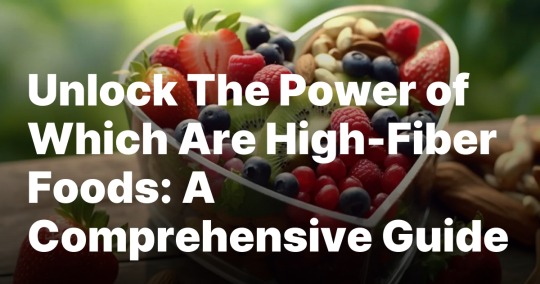
View On WordPress
#Balanced Diet#Blood Sugar Control#Cereals and Grains#cholesterol levels#Colon cancer#Daily Fiber Intake#dietary choices#Digestive health#digestive system#FAQs#fiber content#fiber sources#Fiber Supplements#fiber-rich foods#fruits and vegetables#Health and Wellness#Health Benefits#Heart health#high-fiber foods#Insoluble Fiber#Legumes and Beans#Meal Planning#Nutritional Guide#Nutritional Information#nuts and seeds#portion sizes#Soluble Fiber#Weight Loss
0 notes
Text
Watching creators across the internet yap themselves into hating this game for no reason is actually so sad
#honey i promise you are allowed to like things#some of y'all are talking yourself into a hole in the name of content and i am literally watching the light leave your eyes#at some point we collectively decided that art is only as good as the most niche and unnecessary criticism you can make of it#we admire a painting only a moment before we comb through the paint to find the fibers the brush left behind#it's not fun!#it's dressed up as literary criticism but so much of what i'm seeing is objectively not that#you're robbing yourself of beauty and enjoyment and the vulnerability of joy in spite of art's flaws#you don't have to be perfect and neither does the art you love#just stop talking and enjoy yourself#it doesn't make you unintellectual or morally inept despite what the internet says#fandom critical#dragon age veilguard#datv#dragon age#da4#dragon age the veilguard#veilguard
261 notes
·
View notes
Note
hey Dr Jekyll! With all the shenanigans happening recently, have you had any time to work on your—cough—side project?
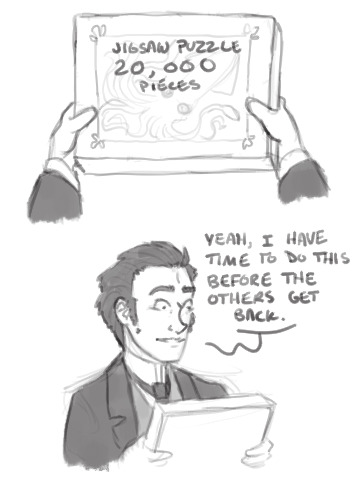
#lxgf#ask#lxgf bonus content#lxgf edward hyde#the other joke i almost did was hyde deciding to take up a fiber art#jekyll takes the potion and then stays up all night knitting a blanket
129 notes
·
View notes
Note
I found fibrecraft tumblr after searching drop spindles because my dad *didn’t even know what that was.* And despite having been firmly of the opinion that I didn’t intend to learn it, y’all have me getting ever closer to giving in. However, I’m also growing ever more enamored with the idea of weaving - and despite recently deciding to give knitting and crochet another go - I think it looks the most fun of the fiber crafts. My issue is that I have absolutely no space.
But I’m beginning to realize there’s a lot of different looms and types of weaving. So I was wondering if you have any resources or tips for small space methods and storage?
welcome to fibrecraft tumblr! it's fun here, we have enablers.
i will admit that while i love knitting, weaving is amazing, and is much better with regards to instant gratification—weaving for an hour gets you a lot more fabric than knitting for an hour.
so let's talk about weaving, because i have great news for you: you can 100% totally weave in a small space if you want to, and you even have options for how you do it. i'm going to go through basically all the small space weaving options that i'm aware of in roughly size order, and if you make it to the bottom of this you'll have a pretty good overview of space-saving weaving methods.
the first question to ask yourself is what you want to weave. maybe you're not sure yet, which is totally fine. if you don't immediately have strong feelings about it, though, maybe consider if band weaving strikes your fancy. this is pretty limited in size, but lets you weave belts, straps (like camera or bag straps), lanyards, etc.
if you think that sounds neat, it's worth looking into tablet weaving, an inkle loom, or a band/tape loom. tablet weaving takes up no space at all—if you can fit a stack of index cards into your life, you can fit tablet weaving. the tablets are small square cards, often made out of heavy cardstock, and even with a project on them, you can probably fit them into an index card holder.
inkle looms are larger, and to be honest i've never used one and don't know a ton about them, but they're also used for making woven bands. the looms can also be very aesthetically pleasing, if that's something you're into. they can be very big, but the ashford inklette, for example, is only 36 cm long and maybe 12 cm wide.
tape looms are—in my experience, anyhow—larger than tablet weaving but smaller than inkle looms, and even the larger ones are only about shoebox size. they vary widely, from gorgeous, complicated little looms to a handheld paddle that you use to create a shed, which is what you put your yarn through when you're weaving.
if that doesn't sound like good times, consider a frame loom. these are pretty simple—if you ever wove potholders out of stretchy cloth strips as a kid, you probably used a frame loom to do it on. frame looms are generally inexpensive and readily available, and can be used for small woven objects like potholders, coasters, placemats, etc. they can also be used to make some truly stunning tapestries. while you can buy a huge frame loom, you're still only talking about huge in two directions—it might be as wide as your armspan, but it's still only a couple inches thick.
another option is a pin loom. these don't get mentioned a lot, and i'm not totally sure why. pin looms are shapes with a bunch of pins (metal points, usually) coming out of them. on one hand, you're limited to making things that are the shape of the loom, but on the other hand, if you've been hanging around fibrecraft tumblr, you've seen all the things crocheters get up to with granny squares, right? there's no reason in the world that you can't do all those things with the squares made on a pin loom. or the hexagons! or the triangles! i've been kinda thinking about getting a little hexagon or triangle pin loom and using it to sample my handspun, then turning the shapes into a blanket.
if you hate all of that, that's ok! we have more options.
you could consider a backstrap loom, which is an ancient way of weaving that's still practiced today in many places. backstrap looms are cool because you can weave probably 24 inches wide on them, but even with a project on it, they take almost no room at all. backstrap looms are fairly easy to diy, because they're basically a bunch of dowels, so they can be a good low-cost way to try out weaving. backstrap looms will let you make longer, wider fabric than anything else we've mentioned so far!
another option—stay with me—is a toy loom. there are a number of cheap looms for sale on amazon/ali express/some local places that are actually fully functional looms. recently i've seen a number of people (like sally pointer, though i'm sure i've seen someone using one of the brightly coloured harness looms, as well) who've used them and report that they're functional, if basic, looms. you're fairly constrained in terms of project size, since there's not a lot of space for the finished fabric to wind on, and there's a very limited width, but the looms are quite small and tuck away easily.
ok, but so what if you hate all of those options? don't worry—there are more options! this is the part where things get expensive, though.
as looms go, rigid heddle looms are actually quite reasonably sized. i think the smallest one i've seen is a 40cm (~16") weaving width, which is about 50x60 (20x24") in length/width, and 13cm (5") high. so that's more space than anything else we've talked about, but it's still not a ton of space, you know? a 40cm rigid heddle will let you weave lovely scarves and things of that nature—table runners, placemats, strips of woven fabric to whipstitch together into a blanket, etc.
but maybe that's enough. so let's talk about table looms. some of them are quite large—mine, for example, is about a metre square and sits on a frame that it came with. it is not what you would call space efficient. but many of them, especially modern ones, are very compact, and can even be folded up into something more or less briefcase sized. (weird way to consider it, since the last time i saw a briefcase was probably the 80s, but you know what i mean, i bet.) the cool part here is that you can weave damn near anything you want on a table loom. the less cool part is that for the compact ones that fold up, you're looking at hundreds if not thousands of dollars. the smallest one i'm aware of is the louët erica, which folds down to 42x62x42cm (16.5x24.5x16.5") and gives you 40cm (16") of weaving width. i feel like that's impressively small. you'd have to decide for yourself if that's enough to justify the $500 usd/$800 aud price tag, though.
finally, we've come to folding floor looms. i don't think someone who's never woven before should run out and buy one of these unless money is just literally not at all a concern for you, but they are basically the dream for those of us trapped in crappy rentals, and it seemed weird to leave them out when i'd come this far.
some floor looms are various levels of collapsible. to be clear, this does you absolutely no good at all when you're actively weaving, because you have to unfold them to weave, but it does you a lot of good if you'd like to have a floor loom and still have the ability to, say, walk through the living room when you're not actively using the loom.
most relevant to our discussion about small weaving footprints, some looms fold up entirely. they are incredibly fucking expensive and incredibly fucking cool. the two that i'm most aware of are the leclerc compact and the schacht wolf line, both of which fold up to about half of their unfolded depth. they're still not small—i think that they're both the better part of 75cm (30") wide and tall, so even if they fold down to 40cm (16") deep, they're still 75cm wide and tall. which is Fairly Large, though much better than having something 80cm deep sitting in the middle of the floor.
this was a very, very long post, but hopefully makes it clear that there's a surprisingly wide range of options, and they all have advantages and trade offs. if you're asking my opinion, my suggestion would be to try something—anything—with a backstrap setup and see how you feel about it. maybe you love it and keep at it forever, in which case you're in good company: there are entire cultures that weave exclusively on backstrap looms.
if you like producing cloth but don't love the backstrap setup, or don't like using your body to tension the warp, you have a lot of other options, and you're out maybe ten dollars of dowels.
personally, my next loom is probably going to be a pin loom. unless i win lotto, in which case it's going to be a house that has a weaving studio and like four floor looms in it. but probably a pin loom.
#weaving#i really hope that this was helpful#i get so excited about solving problems that i sometimes go way too hard#but i love thinking about this kind of thing#sorry for infodumping#also weaveblr i didn't forget about warp weighted looms i just don't think that they're super practical#admittedly i am biased by sharing my house with three cats#but also all the learning to weave content is...not on those#if it weren't for the cats my next loom would be warp weighted tho#fibercrafts#fiber art#textiles#smartest raccoon i know#(it's an ironic tag)
290 notes
·
View notes
Text

This aggregation of many squares continues to grow, somehow…probably because I keep making more squares!
#original content#crochet#fiber art#fiber crafts#granny square#yarn#work in progress#crafting#craft#colorful#patchwork
40 notes
·
View notes
Text
once again weeping over the lack of food options for my senior dog who benefits from a senior formula per our vet but still maintains a normal activity level and doesn't need or enjoy high fiber content
#at one point she was sick and vet put her on RC fibre response and it damn near took her out#some of these senior foods have fiber content to rival that its#pretty wild#shes on eukanuba senior now and handles it well but the bag is running low and as usual#im treating every purchase for spart like im on who wants to be a millionaire and fresh out of lifelines#monster senior looks interesting. comparable to things shes done well on in the past. and she IS a monster so#might be worth a 2kg bag if i stumble across one before we run out
49 notes
·
View notes
Text
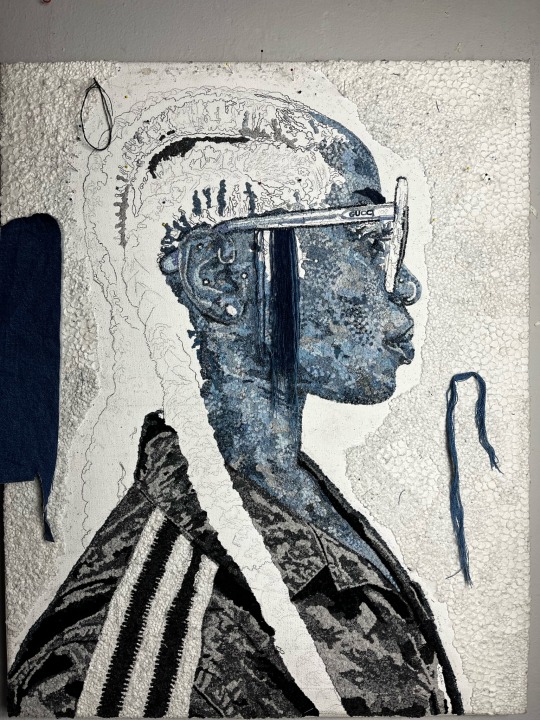

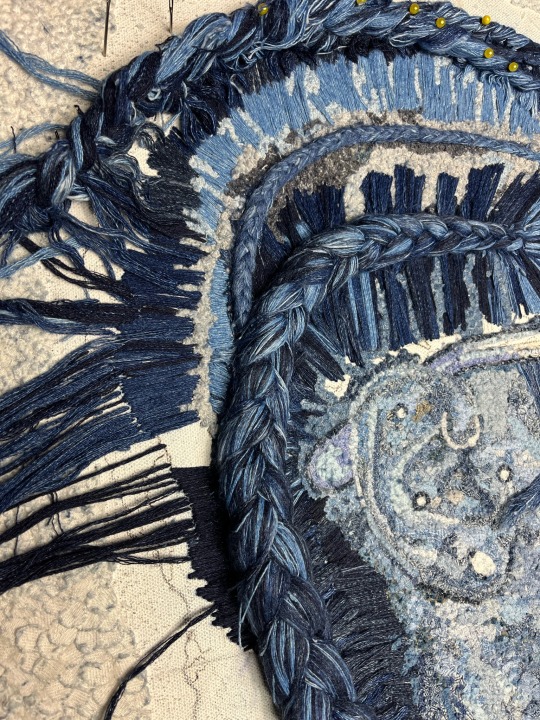
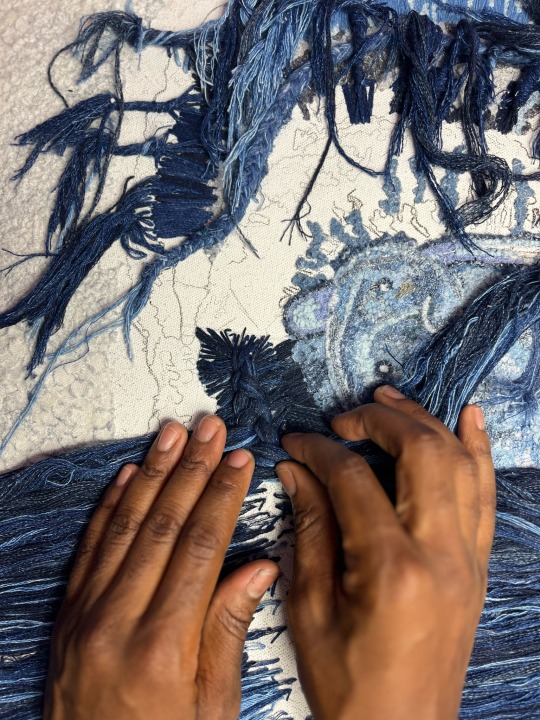
#janettkabeh#artists on tumblr#denim#artwork#denim art#levi’s#jeans#art#pointillism#artist#art wip#hair braiding#embroidery#3d art#original art#illusion#drawing#content#sketch#fiber artist#fiber art#textile art#textiles#fine art#modern art#contemporary art#thread#photography#artistic#artsy
155 notes
·
View notes
Text
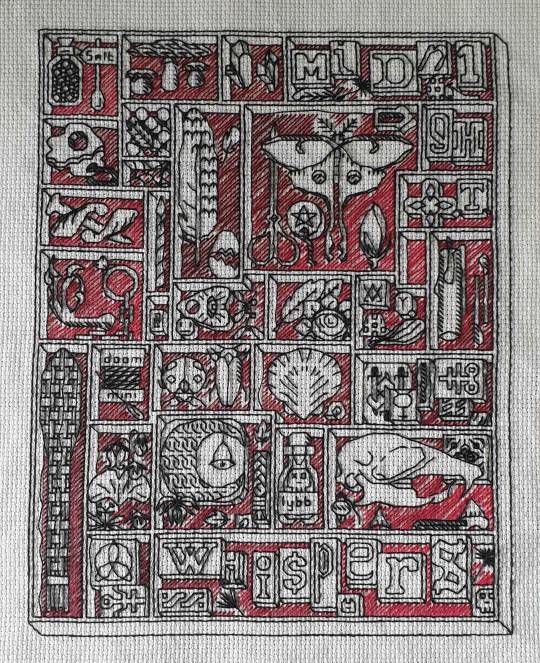
Finally got around to taking a photo of midnight whispers, there's still some bits I need to fix from my thread coming loose, but for now I'm done messing with it.
#my content#my wips#project || midnight whispers sal#crafter#craftblr#crafting#queer crafts#trans crafter#crafts#needlework#blackwork#embroidery#sal#blackwork sal#urban stitches#fibre arts#fiber arts#fiber crafts#wip#craft wip#wip wednesday
82 notes
·
View notes
Text
The brand is Aleani and, to my shame, it is 95% polyester, 5% spandex. I bought it before I really started paying attention to fashion pollution and fiber content. I so think it's some kind of knit weave, though, and that that's part of why it's got the weird relationship with wrinkles.
Visually it is just Very Normal. Modest neckline, half sleeves, limited color palette floral print, diagonal hem with a bit of paneling for interest, and a bow.
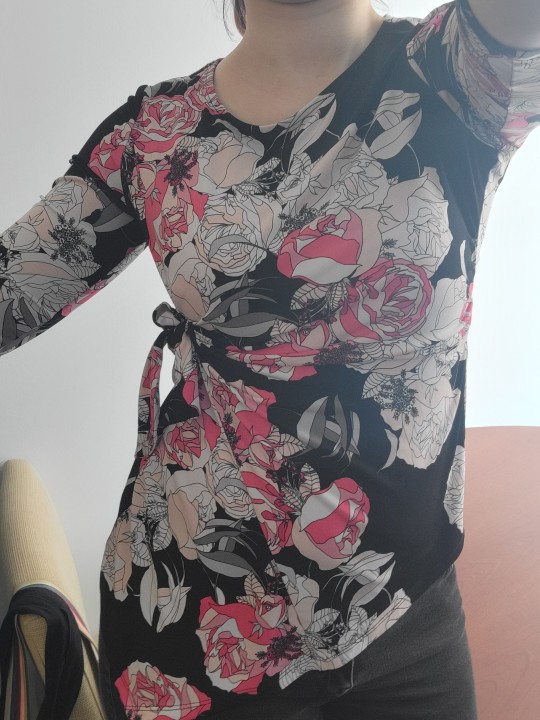


I have this one blouse that I wear all the time for work because. Like. It's not my favorite design. It's a fine, normal floral in black and pink. I like it a normal amount for a work blouse.
But I don't need to iron it. Even if it's wrinkled, I just need to hang it up and by morning, it's smooth.
It is So Convenient
52 notes
·
View notes
Text
I thought I lost my groove (ability to make good dal) but it turns out that I’ve just been doing evil food chemistry to these poor bean starches by presoaking them in the fridge.
You know, where it’s cold…
#mt#yeah yeah it’s good for the fiber content but it’s bad for the texture won’t someone think of the texture?
10 notes
·
View notes